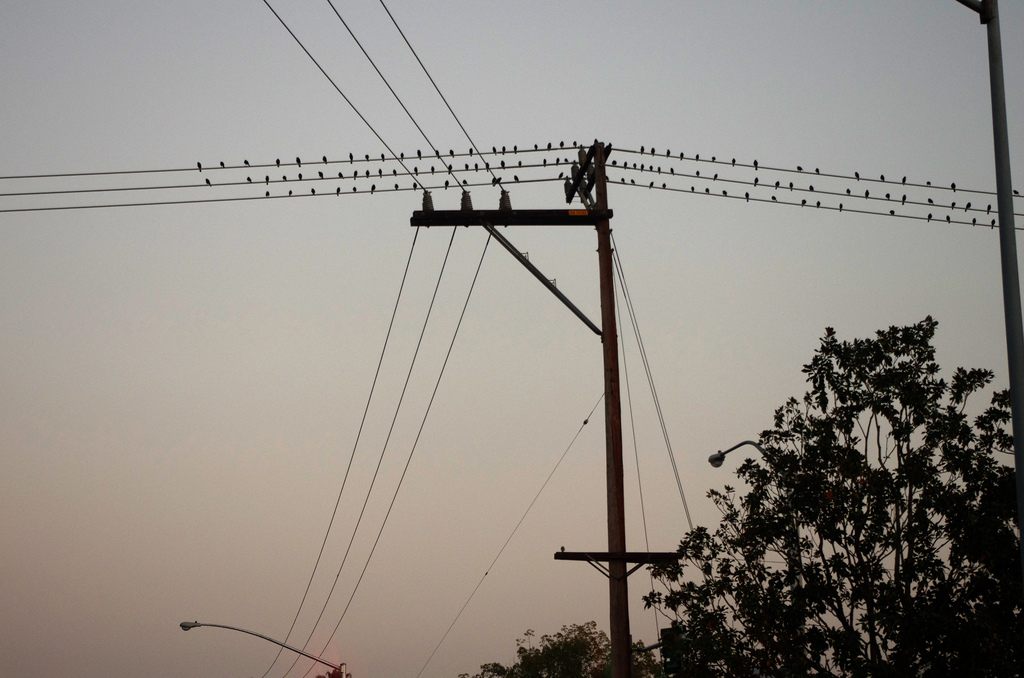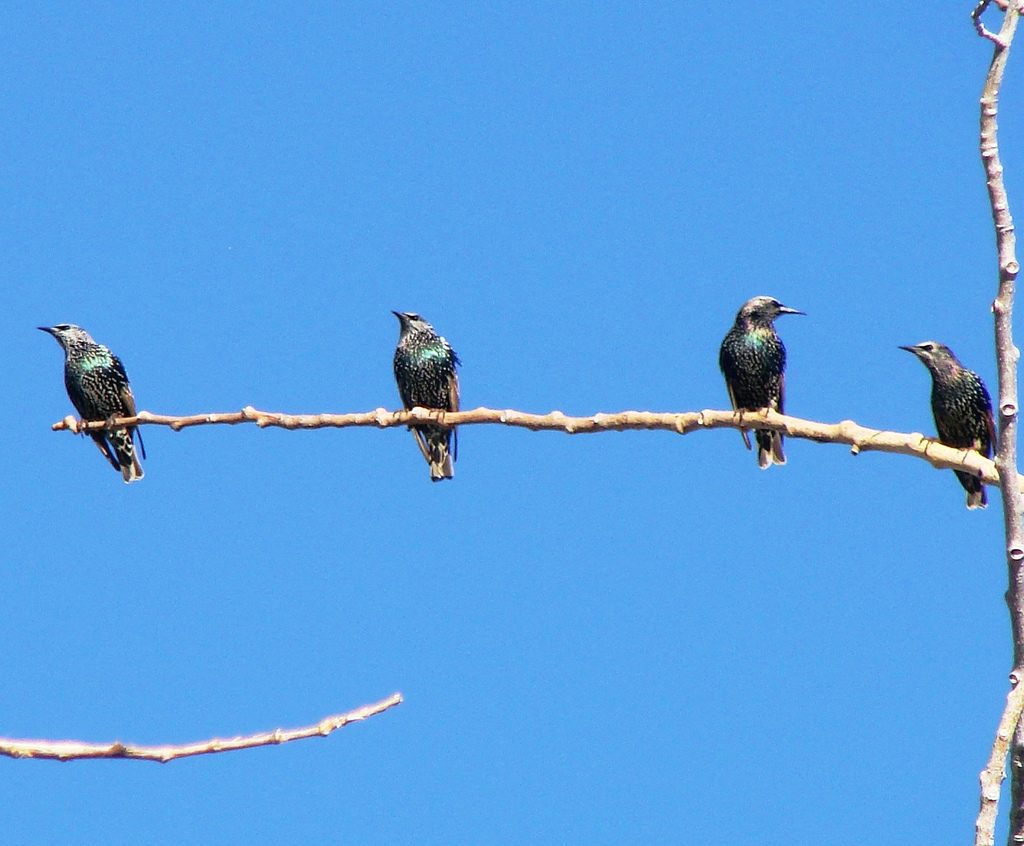The Epic 1959 Battle Between a New York Town and Thousands of Starlings

Starlings on a telegraph pole. (Photo: David Prasad/flickr)
The city of Mount Vernon New York was under siege. The distraught residents had tried to drive their tormentors away with shotguns, fire hoses, rockets, dishpan pounding, huge battleship searchlights and the sounds of trucks blaring the terrifying noises of their enemies in distress.
Still the little black birds wouldn’t leave.
“For ten years, 10,000 starlings have flown into Mount Vernon at twilight in August to settle in tree tops and disrupt lawn parties and besmirch walks, cars and houses,” reads an August 21, 1959 account of the town’s plight in The New York Times.
The circumstances of this invasion are strange but the town’s solution might be even stranger. For starters, the human cause of the problem was long dead by the time the lawn jockeys faced off against the birds. It was 19th century drug manufacturer Eugene Schieffelin who, between 1890 and 1891, released 100 starlings in Central Park. He did this because he was obsessed with both Shakespeare (who references starlings in his texts) and with putting non-native animals into the wild as a member of the American Acclimatization Society, whose purpose was to ferry animals and plants from Europe and transplant them on U.S. shores. (Starlings are indigenous to Europe.) Since the initial birds took flight, Schieffelin’s flock has grown around 200 million strong. They live together by the thousands and create strange, lovely patterns in the air known as “murmurations”. They are noisy; they eat crops; they defecate everywhere; they drive people nuts.

A murmuration of starlings. (Photo: Airwolfhound/flickr)
In 1914, the city of Hartford, CT tied teddy bears to the branches of trees and fired off rockets in an attempt to dislodge a starling infestation. In 1952, Washington, PA tried running electrified wires into starling roosts in order to give the birds “hot-foot”. Two years later, high frequency radio waves were deployed in Rochester, New York.
Desperate times call for desperate measures, which is why the city of Mount Vernon hoped that its savior had been delivered in the form of a 71-year-old man from Great Bend, Kansas named Otto Standke in August 1959. He was a wisecracker, a former phonograph salesman and furniture buyer for Montgomery Ward, and he wore a silver tie pin with the legend “The Bird Man” emblazoned on it.
Standke’s reputation as a starling banisher was polished over the course of many years. He invented his method after growing angry with his hometown for spending $1,000 on aluminum owls to scare starlings, but that ended up providing roosts for the birds. He’d made a business of going around to starling-infested locales and scaring the birds away with a combination of metal clappers, a chime, and a mysterious double-locked box whose contents he refused to disclose. He claimed to have chased birds from several places, most recently Indianapolis, and carried around a mimeographed sheet detailing his triumphs. After checking Standke’s references, the city of Mount Vernon enlisted him in their bird war and promised him a payout of $4,000 if he could rid them permanently of the starlings. He had one week.

Starlings on a branch. (Photo: Phillip Cowan/flickr)
The saga of the bird man and the starlings of Mount Vernon were covered thoroughly by the New York Times, who followed his exploits almost daily at one point, and between August 1959 and September 1960 published 16 stories about Standke.
Upon arriving in Mount Vernon and checking into the $7 a day Hartley Hotel, Standke got down to business. Donning a red-checked cap and smoking a cigar, he proceeded to march around Mount Vernon, bothering starlings with the “very special noise” of his clappers and bell.
Children came out in the street to watch him; the adults held umbrellas over their heads in anticipation of the reactions of thousands of startled birds.
“The starlings fell silent but did not move for fifteen minutes,” read the August 29 account. “Then covey after covey of them flew off as Mr. Standke walked up and down for forty-five minutes.”
So far, so good.

A close up of a starling’s feathers. (Photo: Alden Chadwick/flickr)
But as the days ticked by, it seemed as if the starlings were departing one area simply to land a few blocks away. By August 25th, the people of Mount Vernon decided Standke might need some help and a group of about 100 followed him through the street with Halloween noisemakers and banging pots and pans. Standke fretted that the crowd was impeding his success; his August 27 deadline loomed just two days away.
On August 29, the headline said it all: “Bird-Chaser Sulks as Deadline Passes; Starlings Remain.”
The day arrived, but Standke retired to his hotel room and watched a boxing match. “When police sent a car to The Hartley Hotel tonight to transport Mr. Standke to the battleground he said, ‘I’m not going out tonight,’” the paper wrote.
Irritated, Standke told the Times, “You see, I keep my eyes open, even if I did hardly read the contract. Contracts don’t mean anything to starlings. I’m interested in my reputation as a birdman, not in contracts.”
In the following days, Standke hung around Mount Vernon except for a short trip to New York City for a TV appearance. Finally, it was decided that the city would extend his contract for two weeks. Standke agreed to go back to annoying the annoyers as long as the residents and police officers promised to stop observing his “secret” work. On September 1, he took up his clackers, chime and mystery box again.

Starlings in a tree. (Photo: Micolo J/flickr)
Almost immediately, his efforts were met with resistance. The police insisted that the birds remained. Standke insisted that they were native birds, not starlings, that lingered. The second deadline arrived, the city refused to pay Standke, and he departed, supposedly to chase starlings from Youngstown, Ohio.
“Mount Vernon’s birdman left today with his pancake flappers and other noisemakers,” wrote the Times with barely concealed schadenfreude. “Now, only starlings disturb the evening quiet in Chester Park and Kingsbridge Gardens.”
The next year, the town tried a more straightforward approach: They had the cops blast the birds from the trees with shotguns. “Some residents approve and others complain that the gunfire awakens their children and is a greater nuisance than the starlings,” read a July 19 account.
Not surprisingly, the mayor of Mount Vernon declared this method to be far more effective than noisemakers. At one point, it was reported, the police were killing about 60 birds a night. Some of those were stashed in a refrigerator for use in court to prove starlings still terrorized the town, just in case Standke came calling for his money.
Standke did file a claim in 1960 for the $4,000, but was refused, and this may have settled the matter because—unlike the starlings from Mount Vernon—his name vanished from the headlines.
Today, starlings are members of an exclusive club: They are one of just a short list of animals that are unprotected by the state of New York and can be hunted all year long without limit. Reports on their presence in Mount Vernon are scant, but it seems like lawn parties can go on, unmolested.















Follow us on Twitter to get the latest on the world's hidden wonders.
Like us on Facebook to get the latest on the world's hidden wonders.
Follow us on Twitter Like us on Facebook